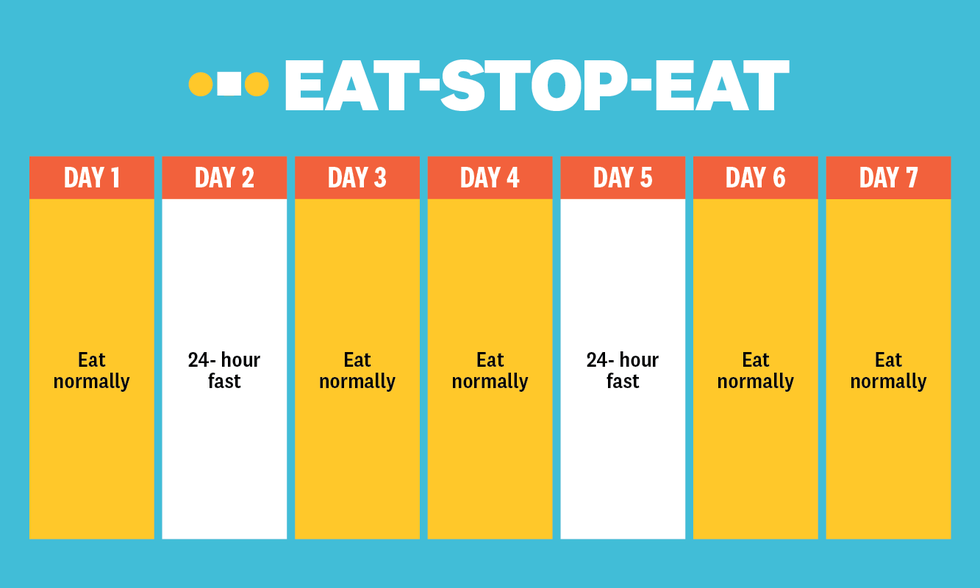Intermittent fasting is a popular and effective weight loss method that has recently gained traction. It involves alternating between periods of eating and fasting, typically 16 hours and 8 hours of eating. This method of eating has been proven to be an effective way to reduce your overall calorie intake, boost metabolism, and promote sustainable weight loss. This blog post will discuss how to use intermittent fasting for effective weight loss, including tips and tricks to get the most out of this dieting technique.
What is intermittent fasting?
Intermittent fasting is a type of eating pattern where meals are consumed in specific periods rather than throughout the day. During the fasting period, no food or drinks with calories are consumed. While this eating pattern is not a diet, it can be combined with a healthy lifestyle to achieve better weight loss results. It has recently gained much popularity due to its reported health benefits.
IF involves limiting the amount of time you eat each day. This can be done by restricting the hours you consume food or skipping meals throughout the day. For example, if you fast for 16 hours and only eat during an 8-hour window, you would have completed one entire cycle of IF. It is possible to do multiple processes within the same day, depending on your specific goals.The idea behind IF is that it allows your body to rest and restore itself between meals. This enables it to burn fat more efficiently, which is thought to lead to weight loss. Additionally, it may reduce inflammation and improve metabolic markers such as cholesterol levels and blood pressure. Studies suggest that IF can even reduce the risk of some chronic diseases.

How does intermittent fasting help with weight loss?
Intermittent fasting is a popular weight loss strategy involving alternating eating and fasting periods. Reducing the number of meals you eat can reduce your total calorie intake and create a calorie deficit necessary for weight loss. It also helps to regulate the hormones that control hunger and satiety, meaning that you may be less likely to overeat or snack between meals. Additionally, intermittent fasting has been linked to improved insulin sensitivity, which can further help with weight loss.
When done correctly, intermittent fasting can lead to healthy and sustainable weight loss. Studies show that it can cause up to 8% weight loss in 3–12 weeks. Furthermore, most weight loss is typically from fat rather than muscle. However, it is essential to note that results will vary depending on diet and lifestyle.
The different types of intermittent fasting
Intermittent fasting is a popular weight-loss approach that provides numerous health benefits. It involves alternating periods of eating and fasting to help you reach your goals. There are several different types of intermittent fasting, each with its unique benefits and approaches to weight loss.
The most common types of intermittent fasting include the 16/8 method, the 5:2 diet, alternate-day fasting, and the warrior diet. Each of these has a slightly different approach to weight loss and requires a different commitment level.
The 16/8 Method: This type of intermittent fasting requires you to fast for 16 hours and eat only within an 8-hour window. For example, you could fast from 7 pm to 11 am and then eat between 11 am and 7 pm. This is a popular choice for those just starting with intermittent fasting, as it is easy to maintain.
The 5:2 Diet: This type of intermittent fasting involves eating normally five days a week and reducing your calories to 500-600 per day on two days of the week. On these two ‘fasting’ days, you will eat one small meal and then abstain from food until the following day. This is an effective way to reduce calories without drastically cutting back your food intake.
Alternate-Day Fasting: This type of intermittent fasting requires you to fast for 24 hours every other day. This means you would go without food for 24 hours, followed by a day of eating as usual. This type of fasting is more challenging than the other types but can be an effective way to shed pounds quickly.
The Warrior Diet: The Warrior Diet is a more extreme version of intermittent fasting which involves eating one large meal in the evening while abstaining from food throughout the day. It is more restrictive than other types of intermittent fasting and may not be suitable for everyone.
Each type of intermittent fasting has its benefits and drawbacks, so it’s essential to research and find the right approach for you. Whichever type of intermittent fasting you choose, remember to focus on healthy eating and get enough rest during your eating windows.
The benefits of intermittent fasting
Intermittent fasting has many potential benefits for weight loss, health, and longevity. It can help you lose weight by reducing your overall calorie intake and encouraging your body to burn fat for energy instead of glucose. Other benefits include increased energy levels, improved mental clarity, better insulin sensitivity, and better control over cravings. Additionally, intermittent fasting has been linked to lower inflammation levels in the body, improved heart health, and may even help reduce the risk of certain diseases like Alzheimer’s and cancer.
While there are numerous potential benefits to intermittent fasting, it’s important to remember that this practice should be used cautiously and not replace any prescribed treatments or medications. As with any diet or lifestyle change, you should consult a qualified healthcare professional before beginning an intermittent fasting routine.
How to get started with intermittent fasting
Starting an intermittent fasting plan can seem daunting at first, but with a few tips and tricks, you’ll be on your way to achieving your weight loss goals in no time. The first step is to determine which type of intermittent fasting plan works best for you. If you’re looking for the most flexible approach, you may want to try the 16/8 method, which involves skipping breakfast and eating all your meals within an 8-hour window each day. Alternatively, you could choose a more structured plan like the 5:2 diet, which involves eating normally 5 days a week and fasting 2 days a week.
Once you’ve decided which plan is right for you, it’s important to begin slowly and make gradual changes to your eating habits. Start by cutting out snacking or eliminating one meal per day and work your way up to longer periods of fasting. It can be helpful to have a plan in place to keep you accountable and motivated. Tracking your progress in a journal or with an app can be a great way to stay on track and see how far you’ve come.
Finally, make sure to listen to your body throughout the process. Intermittent fasting isn’t for everyone and it’s important to make sure that it is safe for you before beginning. If you find yourself feeling lightheaded or weak during a fast, it’s best to eat something and take a break until you feel better. With these tips, you’ll be well on your way to losing weight with intermittent fasting!
Tips for successful intermittent fasting
Intermittent fasting can be a powerful tool for weight loss, but there are specific tips you should follow to ensure you get the most out of practice. Here are a few tips for successful intermittent fasting:
1. Start Slow: Intermittent fasting is not a one-size-fits-all approach to weight loss. Start with shorter fasting periods and work your way up to longer ones. This will help you get used to the process and ensure you don’t feel overwhelmed.
2. Eat Mindfully: During your eating periods, focus on eating nutritious, whole foods that will provide your body with the energy it needs. This will help keep your energy levels high and make it easier to stay on track.
3. Stay Hydrated: When you’re intermittent fasting, it’s essential to make sure that you stay hydrated. Drinking plenty of water throughout the day will help keep you energized and make it easier to get through your fasts.
4. Have a Backup Plan: If you have a tough time sticking to the fasting schedule, plan for when this happens. For example, allow yourself an extra snack or take a break from fasting until you feel more comfortable.
5. Be Consistent: Consistency is vital in any lifestyle change, and intermittent fasting is no exception. Make sure you’re staying consistent with your schedule and sticking to it as much as possible.
Following these tips will help you get the most out of your intermittent fasting journey and reach your weight loss goals. With enough dedication and consistency, you’ll be on your way to a healthier, happier you!
Possible pitfalls of intermittent fasting
Intermittent fasting can be a very effective weight loss tool, but there are some potential pitfalls you should be aware of before embarking on this type of diet. The most common issue is that intermittent fasting may cause an initial decrease in metabolism as your body adjusts to the lower calorie intake. This can be a short-term problem and will resolve itself as your body adapts to the new routine.
Another potential problem is that many people need help to stick to an intermittent fasting plan due to hunger pangs and cravings. To avoid this, make sure you’re still getting enough calories in the meals you are eating. Also, don’t forget to stay hydrated – dehydration can often contribute to feelings of hunger.
If you’re not used to eating large meals at certain times of the day, adjusting to the new routine of intermittent fasting can be challenging. You may overeat during the feeding windows or feel unsatisfied after a meal because you’re not used to eating large amounts of food at one time. It’s essential to focus on portion control and mindful eating and gradually increase the size of your meals until you get used to the new routine. Finally, there’s a risk of experiencing nutritional deficiencies if you’re not careful about what you eat during the eating window. Ensure you’re getting plenty of nutritious foods, like fruits, vegetables, proteins and healthy fats. Remember that intermittent fasting is not suitable for everyone, and you must speak to a medical professional before making any significant changes to your diet.
How long to do intermittent fasting before seeing results
When it comes to intermittent fasting, the amount of time it takes to start seeing results varies significantly from person to person. Generally speaking, most people who practice intermittent fasting do so to achieve some degree of weight loss. In this case, the time it will take to see results can depend on various factors, including how often you fast, what type of fasting you’re doing, you’re dietary habits, and how much weight you want to lose.
Typically, it’s recommended that people should begin seeing some changes in their weight after two to three weeks of consistent fasting. Of course, if you’re looking to lose a more significant amount of weight, you may need to be more patient and wait for several months before you start noticing results.
It’s also important to note that intermittent fasting isn’t just about weight loss. Other potential health benefits include reduced inflammation, improved mental clarity, increased energy levels, and improved insulin sensitivity. While weight loss is often one of the first results people notice with intermittent fasting, it’s important to note that other benefits may take longer to become apparent.
Overall, there’s no definitive answer to how long it takes to start seeing results with intermittent fasting. It depends on a variety of factors. However, most people tend to experience some changes in their weight after a few weeks of consistent practice. It’s also important to remember that intermittent fasting isn’t just about weight loss; there are other potential benefits too!

About Author: The content is written by Shagufta. She has been writing health article for the past six years.














